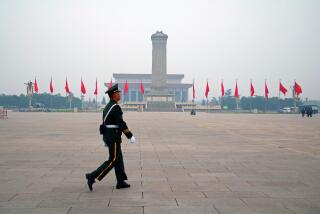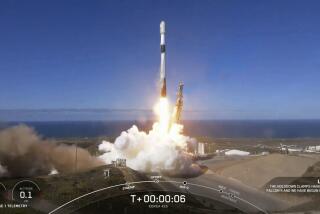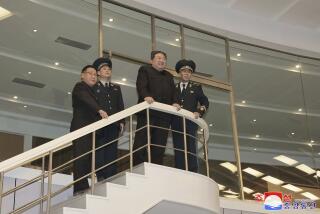China’s new satellite is said to spot pot fields, smuggler routes
China has poured billions of dollars into building a nationwide surveillance network – by one 2013 estimate, the country had 30 million surveillance cameras in parks, on highways and even in taxis.
Now, there’s one more very powerful eye in the sky allowing authorities to keep tabs on things: the Gaofen-1 satellite, which is capturing high-resolution images from 300 miles above the Earth.
Analyses of images captured by Gaofen-1 have enabled Chinese police to locate fields of opium poppy and marijuana in northern China and uncover dozens of routes used by smugglers at the border with North Korea and along the frontier in the restive Xinjiang region, the official New China News Agency reported Monday.
“Chinese scientists definitely did research before on utilizing satellite images to fight crimes,” Xie Tao, a professor who specializes satellite imagery at Nanjing University of Science and Technology, said in an interview. “But now, thanks to the high-resolution images provided by Gaofen-1, they’re finally confident enough to announce the results to the public.”
Gaofen-1 was launched in April 2013 and formally put into service in December. During the first few months of testing after its launch, the satellite (whose name means “high resolution”) provided data on earthquakes, floods and smog in China. Its cameras were capable of capturing objects as small as a bicycle, the news agency said.
But just because a satellite can photograph something doesn’t mean humans are always good at telling what the object really is. In the hunt for the missing Malaysia Airlines Flight 370 this year, for instance, multiple satellite images were offered up by different countries, including China, but the objects captured in photographs proved to be unrelated to the plane.
“To better analyze images captured by the satellite, a basic understanding of the conditions on the ground is essential,” said Xie. For example, when it comes to drug crops, “you need to know what other plants they have in the area before you can distinguish marijuana from the rest.”
Authorities may be having second thoughts about publicizing their capabilities. The China National Space Administration first posted a statement Friday detailing the satellite’s usage in public security efforts. But after Chinese press reported on the marijuana field finds and other details Monday, the statement was removed from the space agency’s website. And the Public Security Ministry on Tuesday denied the satellite found any cannabis farms.
Still, Chinese authorities say the country’s extensive terrestrial surveillance network helps to deter crime and maintain “social stability,” though critics say it constitutes an invasion of privacy and is often deployed to monitor dissidents.
Bo Zhang, who follows China’s surveillance camera market for IMS Research, told National Public Radio last year that 30 million surveillance cameras may be operating in China. That’s one for every 43 people.
Authorities are rapidly adopting new surveillance technology. As part of a crackdown this month aimed at terrorism in Xinjiang, Chinese authorities used drones and satellite communication devices to pinpoint suspects, the space agency said on its website.
Drones also have been used to monitor pollution.
More satellite imaging capability is soon to go online. China launched the second-generation Gaofen-2 satellite last Tuesday. And according to the New China News Agency, five more are to be put into orbit before 2020.
Still, China is playing catch-up with the world’s top players in satellite technology, such as the U.S. -- both in terms of satellite capability and image analysis.
Gaofen-2, China’s most advanced satellite, is capable of capturing images of an object 3 feet long in full color; by comparison, GeoEye-1 -- launched in 2008 from Vandenberg Air Force Base, provides a resolution of objects as small as 1.5 feet. And commercial satellite imagery provider DigitalGlobe announced in July that it plans to launch WorldView-4, capable of capturing objects down to a resolution of about 1 foot, in mid-2016, after the U.S. Department of Commerce recently decided to allow DigitalGlobe to sell imagery with resolution as fine as about 10 inches.
As early as 2009, the U.S. authorities started using satellites to track the activities of drug cartels operating along the U.S.-Mexican border, the Associated Press has reported.
Pictures from space are being used along with other intelligence to pinpoint Mexican narcotics operations and anticipate smuggling attempts into the United States, R. Scott Zikmanis, a deputy director of operations with the National Geospatial-Intelligence Agency, told AP.
In China, as in the U.S., the government’s increasing ability to monitor people’s activities has raised some unease among ordinary citizens, though there’s little they can do about it, except maybe stay home.
“I can’t sunbathe on my rooftop anymore. This is really annoying!” said one of the most-liked comments about Gaofen-1 on social media when word of how its images were being used hit the Chinese news.
Tommy Yang in The Times’ Beijing bureau contributed to this report.
More to Read
Start your day right
Sign up for Essential California for news, features and recommendations from the L.A. Times and beyond in your inbox six days a week.
You may occasionally receive promotional content from the Los Angeles Times.






